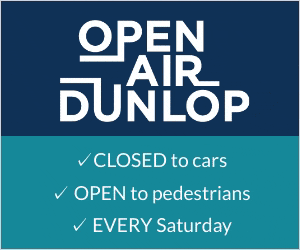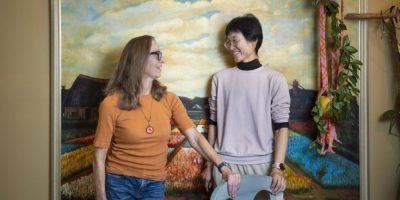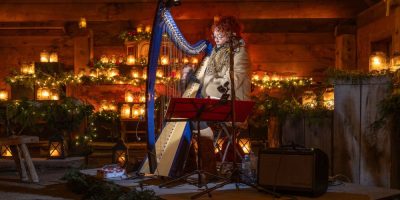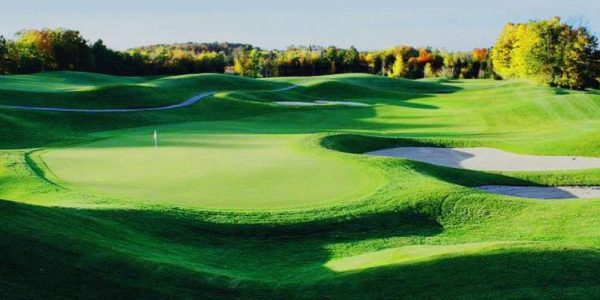
This Barrie 360 content is brought to you by Downtown Barrie BIA
Downtown Barrie is the city’s historical core. That means there are lots of opportunities to learn about Barrie's past. There are also several opportunities to experience Barrie’s art, culture, and entertainment scene.
If you want to explore Barrie’s Downtown but don’t know where to start, here are some places you should be sure to check out.
1. Historic Downtown
Downtown Barrie is part of the City’s original settlement. That means that you can find a wide variety of historic buildings of different ages and designs. For those who love history and architecture, here are some of the most interesting Downtown locations:
Simcoe Hotel
At the center of Downtown Barrie is a historical intersection known as Five Points. The intersection has been there since 1833. But the fifth street was not connected until 1870.
On one of the 5 corners, you’ll find a triangular-shaped building known as the Simcoe Hotel. The original building was built in 1853 but was ravaged by fire years later. Rebuilt in 1876, the original hardwood beams from the 1853 building remain in the cellar.
Sanders Block
To the east of Five Points, between Owen St and Mulcaster, you’ll find Sanders Block. You’ll know you’re in the right place when you spot the name “Sanders Block.” Look for it in white brick atop a 3 story red brick building.
Originally, this building was part of a stretch of buildings called “the rookery.” In the 1870s, the rookery was all that remained of the original roughcast wood buildings that had been built in the 1830s and 40s. It stretched from what is now Hooligans to Homestead Artisan Bakery. In the 1870s, locals saw it as an unsightly hazard.
What Happened To The Rookery
In the place where you can now find Hooligans there used to be a hotel called London House. In 1879 London House burned down. The owner began rebuilding in brick when another fire hit in 1880. The fire partially burned down the new building and took out the rest of the rookery.
Thomas Kennedy was the architect who designed the London House. Following its completion, Kennedy went on to design the Sanders Block and the Bothwell property to its right. Kennedy would complete many more projects in the area over the next few years.
The two buildings to the left of Sanders Block were later demolished to build the new TD Bank in the 1970s.
The McConkey Building
Located next to the original rookery was the McConkey building. Had it not been for this building, the fire that took down the rookery would have likely spread further. But thanks to the forethought of a local businessman, the fire was contained.
You see, in 1866, the local sheriff, Thomas McConkey, was rebuilding his recently burned-down establishment. When he rebuilt, he installed a firewall to prevent the spread of fire and protect his own building. Today, the building is one of the oldest buildings in Downtown Barrie and houses McReilly’s Pub. During renovations of the pub, the owners found the old jail cells that were a part of the sheriff's office.
RELATED: A piece of Barrie’s history uncovered during renovations …
Queen’s Hotel
To the right of the McConkey Building is the original home of the Barrie Hotel. Barrie Hotel was built in 1850 and remodeled in 1873. Had it not been for McConkey’s firewall, the hotel would have likely burned down in 1880.
In 1915, the Barrie Hotel was renamed Queen’s Hotel when the original Queen’s Hotel burned down a few blocks away. The Hotel holds a lot of history and is definitely worth a stop while exploring Downtown Barrie.
Commercial Building
On the opposite side of the road, you’ll find the Commercial Building that was built in 1876. Today it’s home to Bohemia Cafe and J’Adore.
Before burning down in 1873, this area was known as the Boys Block. After the fire, the land was sold to several owners who built a block with 9 stores. The building is supported by Corithian style columns cast at the local iron foundry. From the outside, you can also see the original Terracotta keystones that look like scowling faces between each window.
The Clarkson
Moving further along Dunlop, you’ll find The Artisan Bakery on the northeastern corner of Dunlop and Mulcaster. This building was originally The Clarkson House, which was built in 1871. The building had accommodations upstairs and dining on the main level. Compared to other hotels in the area, The Clarkson offered affordable accommodations.
Today, you can still see the original form of the building. Though much of it has been renovated and updated throughout.
2. Meridian Place & Memorial Square
Meridian Place & Memorial Square connect downtown Barrie to the waterfront. The space provides unobstructed views of Kempenfelt Bay but that’s only part of its attraction.
This award-winning event space always has something going on. From outdoor fitness to concerts and commemorations, it’s a gathering place for locals and visitors. It also holds a lot of history.
How The Area Has Changed Through The Years
The Square is one end of the Nine Mile Portage that goes from Kempenfelt Bay to Willow Creek. This route was used by First Nations and later as a supply route and bypass during the War of 1812. Following the War, it was turned into a rough wagon road and used by fur traders, explorers and early settlers. A plaque about the Portage route can be found at Meridian Place & Memorial Square.
When a railway switch line came into Barrie in 1865, freight sheds were built just south of the square. At that time, the square had become a local green space commonly called “The Gardens.”
In 1984, a post office and customs building was built on the square and it became known as Post Office Square. The building was another of Thomas Kennedy’s works (the architect who built Sanders block).
In 1957, the square was renamed Fred Grant Square after a local historian and journalist. The post office was torn down a year later.
It wasn’t until 1993 that the area was renamed Memorial Square to commemorate its historical significance. And it was another 24 years before the square was remodeled and Meridian Place was added.
What To See At Meridian Place & Memorial Square
Over the years, many monuments and art displays have been installed in this space. While visiting, be sure to check out:
- Bank of Toronto Memorial Drinking Fountain - This water fountain was built in June 1891 and refinished in 1953.
- Cenotaph - A 23’ monument built in 1922 to honour those who lost their lives in WWII. Over the years, names from later wars have been added.
- Flagpole - Commemorates the 75th Anniversary of Rotary International; installed in 1980.
- Artillery Gun - Commemorates 80 years of friendship between Barrie and CFB Borden; presented in 1996.
- Memorial Square Sign - Dedicated to those who served in the Canadian Armed Forces and Merchant Navy.
- Four maple Trees - Planted to honour the four divisions of the Canadian Corps who fought at Vimy Ridge.
- The Urn Wall - Contains soil from the April 1917 battlefields of Vimy Ridge and honours those that fought and died there. It was designed by Marlene Hilton Moore.
- Poppy Crosswalk - Across from the Cenotaph there are three poppies incorporated into the crosswalk. They were added as a way to remember our veterans and their sacrifices.
- The Horn and The Heart - A memorial to a local musician and champion of musical performance, Bob Hunter.
- The Container Project - A storage facility and a mural that adds to the beautification of downtown Barrie.
3. Corner of Mulcaster and Collier St
This area is another significant space in the downtown core that has seen many changes over the years. It’s also a key location for experiencing Downtown’s art, history and culture.
City Hall
During Barrie’s first survey in 1833 the intersection of Collier and Mulcaster was reserved as Market Square. It wasn’t until 1854 that the square was entrusted to the Barrie Town Council. Two years later, the original cornerstone was laid for an impressive building constructed by Alexander Graham. The building became known as the Town Hall and Market Building, or Market Hall.
The first floor was used by the Barrie Farmers’ Market. The second floor was where Barrie Town Council held meetings and went about their business.
THE BARRIE FARMER'S MARKET – The Barrie Farmers’ Market was established in 1846. The organization was granted land at the original market square but in 1952 this grant was nullified. The Town of Barrie was given the right to do anything it wanted with the land at Market Square. However, they agreed that they would provide the Barrie Farmers’ Market with a building and a place of operation. That’s why the Barrie Farmers’ Market is still held at Barrie City Hall to this day. The farmers market is held outside every Saturday in the warmer months. In the winter it moves into the Rotunda.
In 1875 the building was damaged by fire, which led to a remodel 2 years later. During the remodel, they added height to the tower, a third floor and decorative metalwork. It wasn’t until 1959 when Barrie incorporated as a City that the building became City Hall.
This building acted as City Hall until it was demolished in 1985 and the new city hall was built next to it. The location of the old city hall is commemorated by a large arch, which bridges Mulcaster St. The arch mirrors the southern exposure of the 1870s building.
What To See At City Hall
The current City Hall is home to more of Downtown Barrie’s art, culture, and history. The fountain outside city hall is called Circle at the Centre. It was a Rotary project that opened in 1998 and doubles as a skating rink in the winter months. Near the fountain is one of Barrie’s Public Art Displays, called Soapbox. The installation celebrates freedom of speech and encourages visitors to exercise it.
Inside City Hall, you can find plaques and markers in the rotunda and on the second floor. These share information about Barrie and its past. You can also find another of Barrie’s Public Art Displays in an alcove between the first and second floors. The piece is on loan from artist Ted Fullerton.
To see more art, be sure to stop by the gallery located on the first floor. The gallery features art by local visual artists curated by Cultural Development staff.
Barrie’s First Fire Hall
In Barrie’s early days, the fire brigade was housed in a shed behind the Market Building. At the time, they didn’t have a lot of support. Local governments didn’t see the point in funding a group for something that may or may not happen. But as blazes took building after building in the Downtown core, a fire hall became a necessity.
In 1865, a proper firehouse was built at Collier St and Mulcaster St. Eight years later, a fire spread from nearby buildings to the fire hall itself. Unfortunately, the brigade’s only steam engine was damaged in a previous fire and was down for repair. That meant they had no machine power to help fight the blaze. The first engineer of the Barrie Fire Brigade ran back into the fire to save their 4,400-pound steamer but the building didn’t make it.
In 1875 a new fire hall was built. It was the longest-standing of all Barrie’s Halls and much better equipped. Though there was much protest, the building was torn down in 1978. Today, a monument called the Column of Valor can be found at the site of the fire hall. It’s dedicated to the Barrie Volunteer Firefighters.
MacLaren Art Centre
MacLaren Art Centre is our regional art gallery and museum. The Gallery was incorporated in 1986 as the Barrie Art Gallery. Their first gallery was located just down the street from the current location. In 1989, a local businessman left his Victorian home to the Gallery. The Gallery moved to Toronto St and became MacLaren Art Centre.
It wasn’t until 2001 that the MacLaren moved back to Mulcaster St. The MacLaren’s current building was home to Barrie’s 1st library - The Carnegie Library. Before moving in, the Art Centre had a contemporary addition added to the building, combining local history with modern art.
The gallery owns a permanent collection of contemporary Canadian art with over 4,300 pieces. There are multiple galleries, an education center, a sculpture courtyard, and a cafe.
Outside of MacLaren, you can spot more of Barrie’s Public Art Displays. The first is Shlosha, which is a sculpture by Kosso Eloul. It represents the Jewish law and the belief that the world is sustained through three principles: truth, justice, and peace.
The second piece is the Dream Chamber by Sorel Etrog. It speaks to the transformative power of imagination and a belief in human potential. The final piece, Ascension, is based on the Judeo-Christian story of Job. The three steel sections that make up the vertical beam refer to the three trials that confronted Job.
Grey & Simcoe Foresters Regimental Museum
For those looking to learn more about the history of the area, you’ll also want to stop by the Grey & Simcoe Foresters Regimental Museum.
The museum is located in the former Armoury that was built to replace a drill shed that burned down in 1886 at Queen’s Park. The building was used for military purposes until 1914 when a new building was built at Queen’s Park.
The Armoury then became an auxiliary shed and rehearsal hall for the regimental band. Inside the museum, you can learn about the regiments’ contributions. You can also view historically significant artifacts including uniforms, medals, field gear etc.
4. Murals and Other Art Installations
The art displays and installations we’ve already covered are just some of the many pieces to enjoy in Downtown Barrie. There are many other stunning works by local artists that you can take in while exploring.
The first piece is a mural on the west side of Bayfield St between Simcoe St and Dunlop. The mural depicts Lt. Gov. JG Simcoe on Kempenfelt Bay in October 1973. Locally, he’s known for giving Kempenfelt Bay its name. He also founded York (now Toronto) and helped implement institutions such as trial by jury and the court of law.
At 76 Dunlop St West, you’ll find another mural. This one shows the 1905 Allendale Railway Station and Steamer Islay. There’s also a brief story on the history of the two.
Throughout 2022, you can also enjoy the Downtown Barrie Mural Project. As you take in Barrie’s downtown, keep an eye out for temporary wraps, murals and artwork. There are 6 installations altogether. Each features a poetry excerpt with corresponding artwork.
Another temporary art project that you can take in is Brightening Barriers. This program brings original works by local and regional artists to patios throughout Downtown. Each project uses patio fencing as its canvas. This is symbolic of turning “barriers" of imposed separation into a collective artistic experience.
Nine restaurants will be displaying these pieces until September 30, 2022.
- Michael & Marion’s
- Mexhico
- McReilly’s Pub
- Flying Monkeys Craft Brewery
- Bohemia
- The North
- North Country
- Kenzington Burger Bar
- Groovy Tuesday’s Bistro
5. The Music Scene
With live shows and music festivals at Meridian Place, in restaurants, and on the street, Downtown Barrie is a hum for music and entertainment.
One major addition to Downtown is the Emerging Artists and Busking Program. The program is a partnership between the Downtown Barrie BIA and the Ontario/Canadian Musicians Co-operative.
The Emerging Artists Program helps launch musical careers and supports young artists in the music industry. It provides a platform for musicians to showcase talent and creates a lively and dynamic atmosphere in the City's core.
The Busking Program is a pilot project under the Emerging Artists Program. The goal of this program is to animate the streets of Downtown Barrie with music, poetry, juggling and more. To view buskers from the program, head to the Barrie Marina Office or Five Point Theaters.
While Downtown, you can also play at the outdoor piano located in Memorial Square & Meridian Place. The piano was donated by Forgather Floral Co. and painted by local artists Katie Green and Marlisha Lewis of Spare Room Barrie.
6. Theatre & Film
Downtown Barrie also has exciting opportunities to take in theater and film.
As you may have guessed, Five Points Theater is located at the historical Five Points intersection. The theater is managed by Barrie’s Department of Culture. It hosts regular theatrical performances as well as shows for dance and music. It’s also a rentable location for camps, workshops, conferences and more.
These are just some of the many things to see in Downtown Barrie. There are also opportunities to experience arts, culture and history just steps from the Downtown core, including:
- The Waterfront Heritage Walking Trail
- Heritage Park
- The Barrie Public Library (with a local history room)
- Barrie Native Friendship Centre
So, what are you waiting for? Head downtown and start exploring!












